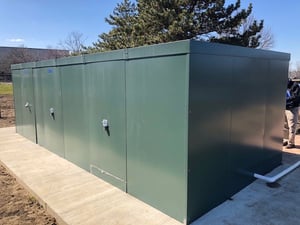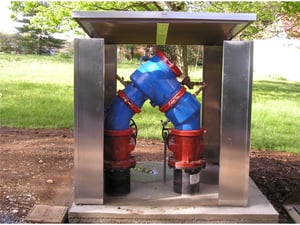 There are many choices in the marketplace to choose from when considering how to cover pumps and mechanical equipment. Whether it’s a small hydraulic pump or a large booster pump, there are all sorts of modular buildings, enclosures and boxes available, and made with everything from heavy steel to fiberglass. They come in all different sizes and shapes and have different ways of opening, like the famous “clamshell” models. Some even need expensive, time consuming permits to allow people to access them for regular tasks and maintenance. Others need to be secured directly to a skid and moved from project site to project site.
There are many choices in the marketplace to choose from when considering how to cover pumps and mechanical equipment. Whether it’s a small hydraulic pump or a large booster pump, there are all sorts of modular buildings, enclosures and boxes available, and made with everything from heavy steel to fiberglass. They come in all different sizes and shapes and have different ways of opening, like the famous “clamshell” models. Some even need expensive, time consuming permits to allow people to access them for regular tasks and maintenance. Others need to be secured directly to a skid and moved from project site to project site.
Pump manufacturers and customers want a simple streamlined enclosure that provides easy access to equipment while keeping equipment safe and operable when needed. They also want to keep pumps cool in the summer and warm in the winter.
We would like for you to consider an alternative solution to the traditional boxes mentioned above and discuss the advantages of using aluminum paneled enclosures for your next pump project.
Aluminum paneled enclosures are constructed from individual insulated panels able to be quickly assembled on-site and easily disassembled if needed. A a result, aluminum enclosures are not considered to be a permanent structure: no need for permits!
Don’t mistake a non-permanent structure for not being secure. They can be secured to concrete slabs or portable skids for transportation from project site to project site. Aluminum is easy to work with and can be customized to meet almost any specific size requirement. Regardless of the brand or size of pump, or a particular application’s layout, an aluminum paneled enclosure can be a solution for your needs.
Another issue to consider is the removal of heat generated by pump(s). The last thing anyone needs is a pump to overheat and cause motor failure. Adding features like louvers and/or exhaust fans will keep everything cool and running, even when the summer temperatures get up there. Depending on what fluid the pumps are pushing, it could be critically important to provide additional heat in the winter months. Take hydraulic pumps for example. As we all know, hydraulic fluid can become extremely viscous when it gets cold, so you’ll want to make sure to keep pump equipment warm so that it can continue to supply receiving equipment. Heaters can either be mounted on the concrete slab for more permanent applications or on the walls of the enclosure if it’s skid-mounted.
 Maintenance or swapping out equipment is also an important feature when covering pumps. By utilizing an aluminum paneled enclosure, accessing equipment is made simple by backing out a few screws to completely remove the roof. This way you have unobstructed access to the equipment, which can be a better solution versus the old “clamshell” enclosures that don’t always open to 90 degrees and have to ultimately be modified to provide complete access. Since the enclosure is made from individual panels, lockable access panels can be placed wherever needed to gain access to control panels or pumps that need to be routinely tested and maintained. Simply twist the door handle and remove the panel.
Maintenance or swapping out equipment is also an important feature when covering pumps. By utilizing an aluminum paneled enclosure, accessing equipment is made simple by backing out a few screws to completely remove the roof. This way you have unobstructed access to the equipment, which can be a better solution versus the old “clamshell” enclosures that don’t always open to 90 degrees and have to ultimately be modified to provide complete access. Since the enclosure is made from individual panels, lockable access panels can be placed wherever needed to gain access to control panels or pumps that need to be routinely tested and maintained. Simply twist the door handle and remove the panel.
When it comes to aesthetics, aluminum enclosures can be painted in all sorts of colors and even vinyl wrapped with your favorite logo or backdrop to blend in with the surrounding environment.
Finally, paneled enclosures are shipped flat in a box significantly reducing freight costs and damage.
You have many choices when it comes to covering and protecting critical pumps and equipment. But when you review the advantages of an aluminum paneled enclosure as your solution, there really isn’t a choice to be made. Speak with a Safe-T-Cover design expert today and see how our enclosures are the ideal solution for your needs.




